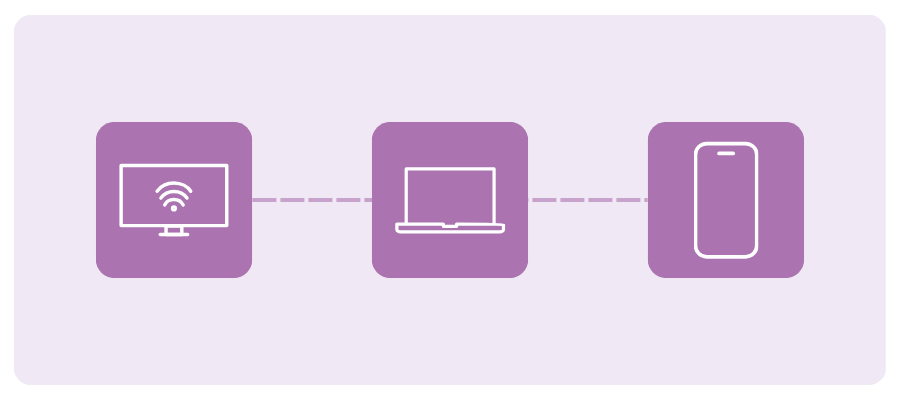At A Glance
Infillion and Experian collaborate to help advertisers connect with audiences across devices and channels, as cookies and mobile identifiers disappear. By integrating Experian's Digital Graph and Offline Identity Resolution, Infillion strengthens identity connections, improves campaign reach, and enhances audience engagement across CTV, mobile, and web.In our Ask the Expert Series, we interview leaders from our partner organizations who are helping lead their brands to new heights in AdTech. Today’s interview is with Ben Smith, VP of Product, Data Products at Infillion.
Adapting to signal loss
What does the Experian–Infillion integration mean for advertisers looking to reach audiences as signals fade?

As cookies and mobile identifiers disappear, brands need a new way to find and reach their audiences. The Experian integration strengthens Infillion’s XGraph, a cookieless, interoperable identity graph that supports all major ID frameworks, unifying people and households across devices with privacy compliance, by providing a stronger identity foundation with household- and person-level data. This allows us to connect the dots deterministically and compliantly across devices and channels, including connected TV (CTV). The result is better match rates on your first-party data, more scalable reach in cookieless environments, and more effective frequency management across every screen.
Connecting audiences across channels
How does Experian’s Digital Graph strengthen Infillion’s ability to deliver addressable media across channels like CTV and mobile?

Experian strengthens the household spine of XGraph, which means we can accurately connect CTV impressions to the people and devices in that home – then extend those connections to mobile and web. This lets us plan, activate, and measure campaigns at the right level: household for CTV, and person or device for mobile and web. The outcome is smarter reach, less waste from over-frequency, and campaigns that truly work together across channels.
The value of earned attention
Infillion has long championed “guaranteed attention” in advertising. How does that philosophy translate into measurable outcomes for brands?

Our engagement formats, such as TrueX, are based on a simple principle: attention should be earned, not forced. Viewers choose to engage with the ad and complete an action, which means every impression represents real, voluntary attention rather than passive exposure. Because of that, we consistently see stronger completion rates, deeper engagement, and clearer downstream results – like lower acquisition costs, improved on-site behavior, and measurable brand lift.
To take that a step further, we measure attention through UpLift, our real-time brand lift tool. UpLift helps quantify how exposure to a campaign influences awareness, consideration, or purchase intent, providing a more complete picture of how earned attention translates into business impact.
Creative innovation and location insights
Beyond identity resolution, what are some of Infillion’s capabilities, like advanced creative formats or location-based insights, that set you apart in the market?

One key area is location intelligence, which combines privacy-safe geospatial insights with location-based targeting through our proprietary geofencing technology. This allows us to build custom, data-driven campaigns that connect media exposure to real-world outcomes – like store visits and dwell time – measured through Arrival, our in-house footfall attribution product.
We also build custom audiences using a mix of zero-party survey data, first-party location-based segments, and bespoke audience builds aligned to each advertiser’s specific strategy.
Then there’s creative innovation, which is a major differentiator for us. Our high-impact formats go beyond static display, such as interactive video units that let viewers explore products through hotspots or carousels, rich-media ads that feature polls, quizzes, dynamic distance, or gamified elements, and immersive experiences that encourage active participation rather than passive viewing. These creative formats not only capture attention but also generate deeper engagement and stronger performance for a variety of KPIs.
Future ready media strategies
How does Infillion’s ID-agnostic approach help brands future-proof their media strategies amid ongoing privacy and tech changes?

We don’t put all our eggs in one basket. XGraph securely unifies multiple durable identifiers alongside our proprietary TrueX supply to strengthen CTV household reach. This agnostic design allows us to adapt as platforms, regulations, and browsers evolve – so you can preserve reach and measurement capabilities without getting locked into a single ID or losing coverage when the next signal deprecates.
Raising the bar for media accountability
Looking ahead, how is Infillion evolving its platform to meet the next wave of challenges in audience engagement and media accountability?
From an engagement standpoint, we’re expanding our ability to support the full customer journey, offering ad experiences that move seamlessly from awareness to consideration to conversion. That includes smarter creative that adapts to context, intelligent targeting and retargeting informed by real data, and formats designed to drive measurable outcomes rather than just impressions.
When it comes to accountability, we’re ensuring that measurement is both flexible and credible. In addition to our proprietary tools, we partner with leading third-party measurement providers to validate results and give advertisers confidence that their investment is truly performing. Within our DSP, we emphasize full transparency and log-level data access, ensuring advertisers can see exactly what’s happening on every impression.
All of this builds toward the next era of agentic media buying – one enabled by our MCP suite and modular, component-based tools. This evolution brings greater accountability and next-generation audience engagement to an increasingly automated, intelligent media landscape. Our goal is to help brands connect more meaningfully with audiences while holding every impression – and every outcome – to a higher standard of transparency and effectiveness.
Driving impact across the funnel
What is a success story or use cases that demonstrate the impact of the Experian–Infillion integration?
We recently partnered with a national veterans’ organization to raise awareness of its programs for injured or ill veterans and their families. Using the Experian integration, we combined persistent household- and person-level identifiers with cross-device activation to reach veteran and donor audiences more precisely across CTV, display, and rich media. The campaign achieved standout results – industry-leading engagement rates, a 99% video completion rate, and measurable lifts in both brand awareness (3.6 % increase) and donation consideration (13.7% lift). It’s a clear example of how stronger identity and smarter activation can drive meaningful outcomes across the full funnel.

Contact us
FAQs
Identity resolution ensures accurate connections between devices, households, and individuals. Experian’s Offline Identity Resolution and Digital Graph strengthen these connections for improved targeting and consistent measurement across CTV, mobile, and web.
Solutions like Experian’s Digital Graph enable brands to connect first-party data to household and person-level identifiers, ensuring scalable reach and compliant audience targeting legacy signals fade.
Focusing on earned attention (where audiences actively choose to engage) leads to stronger completion rates, improves on-site behavior, and drives measurable increases in brand awareness and consideration.
By linking CTV impressions to households and extending those connections to mobile and web, Experian’s identity solutions ensure campaigns work together seamlessly, reducing over-frequency and improving overall reach.
About our expert

Ben Smith, VP Product, Data Products
Ben Smith leads Infillion’s Data Products organization, delivering identity, audience, and measurement solutions across the platform. Previously, he was CEO and co-founder of Fysical, a location intelligence startup acquired by Infillion in 2019.
About Infillion

Infillion is the first fully composable advertising platform, built to solve the challenges of complexity, fragmentation, and opacity in the digital media ecosystem. With MediaMath at its core, Infillion’s modular approach enables advertisers to seamlessly integrate or independently deploy key components—including demand, data, creative, and supply. This flexibility allows brands, agencies, commerce and retail media networks, and resellers to create tailored, high-performance solutions without the constraints of traditional, all-or-nothing legacy systems.
Latest posts

As we approach 2024, marketers must grasp the evolving landscape of digital activation. Understanding emerging audience trends and activation strategies is key to developing impactful marketing initiatives and positioning your brand for success. In Experian's 2024 Digital audience trends and predictions report you'll find: Data-driven insights that will empower you to confidently develop marketing strategies that resonate with your audience and drive meaningful results. Insights from Experian experts and our industry-leading data. Our outlook for 2024 marketing trends. In this blog post, we'll provide a sneak peek of the 2024 marketing trends you can expect in our full report. Digital activation Digital activation grew by 63% between 2022 and 2023. We expect digital activation to increase in 2024 but at a slower rate than in 2023 due to economic uncertainty caused by high-interest rates, recent state privacy regulations, and work stoppages in the entertainment and automotive industries. Top digital audiences Which digital audiences are advertisers purchasing from Experian? We are seeing growth in four major data categories: Automotive, Demographics, Lifestyle and Interests, and Retail Shoppers: Purchase Based audiences. Here are a few audiences within these categories that you can activate on-the-shelf of your preferred platform: Automotive: Autos, Cars, and Trucks > In Market-Make and Models Demographics: Demographics > Homeowners/Renters > Renter Lifestyle and Interests: Lifestyle and Interests (Affinity) > Activities and Entertainment > Wine Lovers Retail Shoppers: Purchase Based: Retail Shoppers: Purchase Based > Food and Drink > Restaurants: Fast Food/QSR Chicken Frequent Spenders Top digital audiences by industry What are the top digital audiences being activated by industry? Download our 2024 Digital audience trends and predictions report to discover the top digital audiences in the following industries: Automotive Health Financial Services Retail & CPG Download our new 2025 Digital trends and predictions report Marketers, agencies, and platforms are facing new challenges as privacy regulations evolve, AI technology advances, and consumer behaviors shift. Our latest report highlights actionable strategies for navigating these changes and improving how you connect with audiences, measure impact, and deliver results. What you'll learn Navigating signal loss: Explore the rise of alternative IDs and contextual targeting as privacy regulations and signal loss reshape data-driven advertising. Connected TV (CTV): Understand the growth of connected TV (CTV), the importance of frequency capping, and strategies for effective audience activation. Omnichannel campaigns: Learn how marketers are moving from channel-specific strategies to audience-led omnichannel campaigns that tell a more cohesive story. Retail media networks: Learn how retail media networks (RMNs) are capitalizing on enriched first-party data to learn more about their customers and reach them across on-site and off-site inventory. Curation: Examine how curation is transforming programmatic campaigns by combining audience, contextual, and supply chain signals to deliver premium inventory packages that maximize addressability, efficiency, and performance. Download now Contact us Latest posts

2023 has been an unprecedented year for AdTech. With new challenges arising every day — from ongoing signal loss to changing consumer privacy regulations– staying on top of trends is more important than ever before. To help you stay informed on successful tactics from across our ecosystem we’ve compiled a list of our top five 2023 AdTech blog posts. Keep reading to learn about the top themes from CES and Cannes this year, why contextual targeting is so popular, and more – so you can remain competitive in today's rapidly changing environment. #5 CES 2023: Clean rooms, activation, and more Experian attended CES in January to kick off the AdTech year, connecting with partners, clients, and industry leaders to understand their challenges and goals. Discussions were focused on clean rooms and digital activation to address data deprecation and consumer privacy. Clean rooms have the potential to standardize data and address interoperability issues. Digital activation was predicted to increase significantly in 2023, with more focus on demand-side, video, and supply-side platforms. Did digital activation increase in 2023? Download our 2024 Digital audience trends and predictions report to find out. Read our full 2023 CES recap here. #4 Experian identity resolution now available in AWS Clean Rooms Earlier this year, Experian announced that our identity resolution solution is now available in AWS Clean Rooms. Through this new partnership, customers can pair Experian's identity capabilities with AWS Clean Rooms to safely collaborate and access deeper insights without exposing sensitive data. Check out the full announcement to hear from Kalyani Koppisetti, Principal Partner Solution Architect at AWS, Matt Miller, Business Development Principal at AWS, and Tyler Middleton, Sr. Partner Marketing Manager at Experian. #3 Four key themes from Cannes Lions 2023 At Cannes Lions 2023, discussions revolved around four main themes: Signal loss: Experts discussed the importance of adapting paid media strategies to align with consumer behaviors. Collaboration: Discussions highlighted the need for industry players to collaborate and focus on solutions that benefit all stakeholders in the ecosystem. Personalization: This was a key topic and emphasized the growing significance of tailored content, data-driven insights, and first-party data solutions for advertisers adapting to cookie deprecation and the evolving consumer privacy landscape. Balancing AI and creativity: Attendees explored how to balance AI capabilities and nurture creativity while maintaining a human touch. Cannes 2024 will be here before we know it and Experian will be there. To get ready, check out this post by Tyler Middleton, Sr. Partner Marketing Manager, to hear from a first-time Cannes attendee, #2 Three key insights from our 2023 Holiday spending report Experian's annual Holiday spending trends and insights report analyzed recent trends, consumer spending habits, and anticipated what was to come in the 2023 holiday shopping season. This blog post covered three key insights from our report: Consumers are starting their holiday shopping earlier, particularly with online sales. Online sales have been increasing year-over-year, surpassing in-store sales. Spending during the 2022 holiday season was lower than in previous years but is expected to be on par with what was seen in 2023. For advice from our experts and access to all of our predictions for this year’s holiday shopping season, download our 2023 Holiday spending trends and insights report today. #1 How contextual ad targeting addresses signal loss Our most viewed blog post of 2023 was How contextual ad targeting addresses signal loss. Marketers are seeking new solutions due to signal loss caused by the phasing out of third-party cookies. Contextual ad targeting offers a way to combine contextual signals with machine learning for more accurate targeting. Experian's Jason Andersen and Yieldmo's Alex Johnston discuss the challenges of signal loss, addressability, the importance of good creative, and tips for digital ad success in this blog post. By understanding contextual advertising, marketers can create powerful and effective campaigns to reach target audiences. Subscribe to our newsletter Sign up for our email newsletter to receive our latest blog posts, product and partnership announcements, thought leadership, and more straight to your inbox. Subscribe Contact us today Latest posts

In this article…Why AI and CTV are a great matchThe rising popularity of CTVHow is AI already being used in CTV?Demand-side platforms Artificial intelligence (AI) and connected TV (CTV) have a perfect synergy that’s revolutionizing how advertisers connect with their audiences. CTV serves as a medium for streaming content, while AI acts as a sophisticated technology that improves the performance of CTV advertising campaigns. The integration of these two technologies has paved the way for advertisers to reach their target audience more effectively, making CTV advertising a powerful and efficient tool. In this blog post, we’ll dive into how these technologies work together — and why you should jump on board with AI for CTV advertising if you haven’t already. Why AI and CTV are a great match CTV and AI are transforming how advertisers connect with their audiences and improving the performance of their advertising campaigns in the CTV space. They work together to make advertising smarter and more enjoyable for everyone involved. AI uses sophisticated computer programs to analyze and understand data, while CTV refers to the streaming services that consumers use at home. But what makes them a great match in advertising? AI uses data to determine which TV ads are most exciting and relevant to certain people, and it can even adjust ads in real time to ensure viewers are always getting the most personalized experience. AI can provide suggestions to viewers based on previously watched content to help them find what they’d enjoy watching next. To sum it up, AI allows for: Precise targeting: AI uses data to determine which TV ads are most exciting and relevant to certain people. Personalization: AI can adjust ads in real time to ensure viewers are always getting the most personalized experience. Effective ad insertion: AI can provide suggestions to viewers based on previously watched content to help them find what they’d enjoy watching next. CTV facilitates these AI-driven strategies for enhanced user engagement and satisfaction. The rising popularity of CTV CTV has become increasingly popular as people change the way they watch TV. Instead of the traditional approach, more viewers are now choosing CTV platforms for their entertainment. One of the main reasons for this shift is that CTV offers greater flexibility and lets viewers watch content at their convenience. The ability to skip ads on many CTV platforms also improves the experience. CTV offers a great opportunity to interact with your target audience in a more engaging way. CTV allows for highly targeted advertising capabilities so you can reach specific demographics and households with tailored messages. Additionally, CTV provides valuable data insights that enable you to measure campaign effectiveness accurately. If you haven’t embraced this advertising channel yet, you may be missing out on a growing and engaged audience. Here are three reasons you should add CTV to your advertising strategy. Global video ad impressions As a global platform, CTV has the unique ability to reach audiences worldwide. Unlike traditional TV, CTV transcends geographical boundaries and brings marketers a global audience, which makes it an ideal channel for global ad campaigns. No matter your target audience, they’re consuming content on CTV. In fact, a recent study showed that 51% of global video ad impressions came from CTV in 2022. This abundance of global video ad impressions generates vast amounts of data, which AI can process in real time to help you make data-driven decisions and optimize your campaigns for diverse international audiences. AI can analyze viewer data from various regions, identify audience preferences and behaviors across borders, and tailor ad content accordingly. These data analysis capabilities ensure your ads get in front of the right viewers. Viewers prefer ad-supported CTV In 2020, the viewing time of ad-supported CTV surged by 55% while subscription video on demand decreased by 30%, according to TVision Insights. Viewers have a well-established preference for ad-supported CTV due, in part, to cost-effective access to premium content. Viewers are more engaged and less resistant to ads, as AI tailors ad content to viewer preferences and behavior to enhance ad relevance. AI-powered insights can also aid in viewer retention and help you optimize your CTV campaigns. By accommodating viewers’ preference for ad-supported CTV and harnessing AI to improve the ad experience, you’re more likely to be successful in your marketing efforts. CTV outpaces mobile and desktop for digital video viewing eMarketer recently reported that U.S. adults spend 7.5+ hours each day on CTV — more than half of their digital video viewing time. Comparatively, they only spend 37.5% of their viewing time on mobile and 10% on desktops and laptops. These statistics demonstrate that CTV has become the preferred platform for digital video consumption, as viewers enjoy larger screens with superior quality for an immersive experience. It's important to note that AI is an essential CTV marketing tool, as it allows for precise targeting and content optimization. By utilizing AI on CTV, you can take advantage of this trend and deliver more engaging and effective campaigns to a growing and engaged audience. How is AI already being used in CTV? CTV has been integrated with AI across various facets and has revolutionized the television landscape. Here's a look at how AI is already shaping the CTV experience: Generative AI ads Generative AI ads are taking CTV personalization to a whole new level. These innovative ads are customized versions of the same CTV ad to suit individual viewers. Some AI tools can generate several versions of the same CTV ad — swapping the actor’s clothing and voiceover elements like store locations, local deals, promo codes, and more — and can create up to thousands of personalized iterations in just a few seconds. Such capabilities are a game-changing approach to connecting with your audience. Next, we dive into the advantages and impact of generative AI ads, and explore their transformative role in CTV advertising. Contextual ads vs personal data Generative AI ads use personal data, such as viewing history and demographics, to create highly personalized ad experiences. This sets them apart from contextual ads, which rely solely on the content being viewed. Using AI to harness this data, you can move beyond traditional contextual targeting and ensure your ads connect with viewers on a more individualized level. Generative AI ads can be used to A/B test Generative AI ads are not just about personalization; they also open the door to A/B testing. Being able to create several versions of one ad quickly allows you to experiment with various ad elements, such as messaging, visuals, and calls to action, to identify what works best for different segments of your audience and drives the best performance. This flexibility is especially valuable for refining ad campaigns and maximizing their impact. What’s next for AI-generated ads like this? The potential of AI-generated ads is exciting. As AI technologies constantly advance, we can expect even more personalized and automated CTV advertising. It’s a good idea to keep up with the latest AI-driven innovations to create more effective ad campaigns in the fast-evolving CTV space. The possibilities are endless, and you’ll likely find the most success when you embrace AI in CTV advertising. Optimize streaming quality AI helps viewers enjoy more seamless CTV experiences. By assessing network speed and user preferences, AI optimizes video quality in real time to reduce buffering interruptions. For instance, streaming platforms use AI to adjust video settings based on a user's connection speed. This guarantees an uninterrupted and enjoyable viewing experience. Review content for compliance AI also has a part to play in quality assurance and compliance management. It assesses content alignment with technical parameters and moderates compliance with local age restrictions and privacy regulations. This means AI can identify and filter out unsuitable content to provide a safer and more enjoyable viewing environment for audiences while safeguarding brands from association with undesirable material. Voice command AI-powered voice command technology is increasingly used to control CTV viewing. This technology is embedded in streaming devices and smart TVs and allows viewers to interact with their CTV content through voice-activated commands. This personalizes the viewing experience and improves convenience, as it eliminates the need for remote controls. CTV-integrated voice assistants like Google Assistant, Amazon Alexa, Apple Siri, and Samsung Bixby offer a more human-like interaction with the television, allowing users to give commands and receive tailored responses. Content recommendations AI can offer content recommendations that provide viewers a more personalized and engaging experience. Major over-the-top (OTT) services like Netflix, Hulu, and Amazon Prime use AI-driven data analysis to deliver tailored content suggestions to their audiences. By analyzing user habits in detail, AI can recommend content based on factors such as actors, genres, reviews, and countries of origin. This personalized approach helps viewers discover content that matches their preferences and enhances their viewing experience. Advertising Programmatic ad buying, driven by AI, automatically matches ad placements to specific audience segments based on behavioral patterns. It improves ad delivery by moving away from gross rating points (GRP) to more intelligent and targeted placements. This benefits marketers by ensuring ads are seen by the right people at the right time. It’s also cost-effective for publishers, as it maximizes the sale of ad spots to suitable buyers. Automatic content recognition (ACR) technology, which AI powers, is integrated into smart TVs and streaming devices to improve ad relevance. It provides contextual targeting and extends the reach of ads across multiple devices. For example, platforms like Roku use ACR data to display ads to viewers who haven’t seen them on traditional TV. Similarly, Samba TV retargets mobile users based on IP address and aligns their viewing habits with their smart TVs. Demand-side platforms CTV advertising relies heavily on demand-side platforms (DSPs) to efficiently manage and optimize ad campaigns. These platforms use machine learning and AI in several important ways: Using machine learning and AI to address data fragmentation Data is abundant but fragmented when it comes to CTV advertising. DSPs are flooded with a massive amount of data, including information about households, viewer behavior, and viewing patterns. This data is far too much for manual analysis to handle effectively, which is where AI comes in. By integrating machine learning algorithms into DSPs, AI can harmonize this fragmented data and provide valuable insights and a holistic view of your audience. AI can process zettabytes of data in real time, which streamlines the decision-making process and empowers you to compete quickly for limited CTV impression opportunities. Predicting advertising outcomes with AI AI is quickly changing the way we predict and optimize advertising outcomes. TV buying and optimization platforms are now using AI to improve ad performance. With machine learning, these platforms can anticipate which ad creatives will produce the best results based on various non-creative factors. These include the context of the ad, the audience's profiles, the time of day it is displayed, and the frequency of the ad display. By relying on AI to make these predictions, you can make sure your campaigns are highly optimized for success and deliver more relevant, compelling ads to viewers. Optimizing generative ads AI is also driving optimization in generative ads. These personalized versions of the same CTV ad can be tailored to suit individual viewers. By utilizing AI-driven analytics, DSPs can process extensive amounts of data in real time and optimize generative ads to ensure they align with viewers' preferences and behaviors. This level of personalization is a game-changer in CTV advertising that boosts engagement and delivers content that truly resonates with the audience. Add AI to your CTV strategy today Integrating AI into your CTV strategy can help you stay competitive and ensure your ad campaigns are effective and engaging. At Experian, we’re ready to help you elevate your CTV advertising and implement AI as part of your strategy. Our solutions, such as Consumer View and Consumer Sync, provide valuable audience insights, enhance targeting capabilities, and optimize engagement on TV. Plus, our partnerships with leading media marketing solutions can help you achieve greater success through effective advanced television advertising. As you incorporate AI into your CTV strategy, you’ll be able to make more data-driven decisions, deliver more relevant content, and reach the right audience at the right time. Explore Experian's TV solutions and empower your CTV advertising with AI today. Start exploring Latest posts